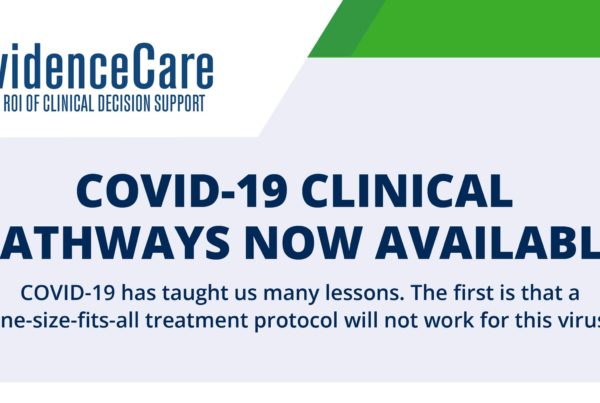There is finally good news around COVID-19 as we seem to be leveling out in some of the areas of the country that were hit early on. The bad news is that other areas are in a full-on war as the virus rapidly escalates while other regions are just now beginning to see an upward trajectory. Even as we are now a few months into the battle, there are still many unknowns, such as how long it will be before we can safely open businesses and get back to life as normal. There is also uncertainty about the potential for resurgence, the efficacy of new medications, the availability of mass testing and tracking, and the readiness of a vaccine. All of this means we cannot afford to let our guards down, and we must continue to look for more effective ways to address the current and ongoing needs of patient care on the front lines.
The need for COVID-19 decision support
Prior to the pandemic, many providers undervalued clinical decision support systems (CDSSs), considering them a “nice-to-have” rather than mission-critical. That may be in part because the traditional approach to care pathways and the distribution of medical evidence is based on retrospective information, which takes years to accumulate and requires providers to spend hours combing through PDFs housed in disparate databases. Even if they find the information they’re looking for, it may be outdated and too narrow in focus. With the pandemic, we now realize the “nice-to-have” is really a “need-to-have,” and that need is urgent.
Having quick access to COVID-19 care pathways is critical for those working on the front lines as well as other triage environments like urgent care, primary care, and telehealth. Many hospitals are having to leverage caregivers from other areas of the hospital to help in the ICU.[1] This means not every ICU staff member will be as experienced in critical care as others, making care pathways even more critical. This is especially important when those most vulnerable, the elderly and patients with underlying conditions, often have comorbidities. That makes it more difficult to understand and treat the unique needs of each patient appropriately.
Technology-enabled pathways
One of the best ways to increase the effectiveness of those in the trenches during this pandemic and beyond is to leverage a technology-based pathway system that is continually updated with the latest COVID-19 findings. For example, EvidenceCare, an industry leader in clinical decision support, quickly created a comprehensive collaborative working with a wide variety of industry content experts as well as providers. The collaborative includes EBSCO/DynaMed, Elsevier, the American College of Emergency Physicians, the Urgent Care Association, multiple hospital systems, and major EHR vendors, all helping to curate the most current clinical pathways for triage and treatment of COVID-19. Once new information is collected, it is digitized and made available through interactive pathways. The knowledge base is updated in near real-time as new information about the virus is discovered. Caregivers can access the patient-specific, evidence-based treatment pathways within just seconds from any digital device in any location. All they have to do is go to the EvidenceCare COVID-19 pathway portal. Once there, they simply choose the appropriate pathway and are presented with evidence or citations to review. They can select the associated process, which is then collated so it can be copied and pasted into the EHR.
This new approach to decision support helps streamline access to the appropriate evidence-based pathways so caregivers can get the most current, accurate information, personalized to the patient’s situation. From initial COVID-19 assessment and evaluation to classification of severity to severity management and disposition criteria, having a real-time, comprehensive decision support tool helps caregivers quickly address and treat each patient’s unique condition faster and with more confidence—even when that patient is in a make-shift hospital in the middle of a park or a vacant school.
The time to act is now
This pandemic has highlighted many weaknesses in our current healthcare system. One of those is that a CDSS is now a necessity, not only for COVID-specific pathways but for the vast array of other conditions caregivers are encountering in the trenches.
We are living in unprecedented times. When urgency matters, there’s no room for ambiguity, and there’s no time to comb through hundreds of clinical decision rules. Every COVID-19 patient is different, and treatment isn’t one-size-fits-all. EvidenceCare pathways provide patient-specific, evidence-based treatment options in as little as 30 seconds, which can mean the difference between life and death. As the pandemic continues to rage across the country, now is the time to take action. EvidenceCare is easy to access, free of charge, and available today.
Information about the pathways is available for all healthcare professionals here, and direct access to the pathways is available here.
[1] https://www.healthleadersmedia.com/clinical-care/coronavirus-tiered-staffing-recommended-bolster-critical-care









